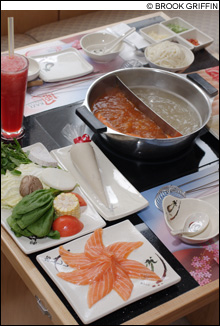
HOT POTS: “Asian fondue” impresses at Kaze. |
Kaze is Boston’s most elaborate presentation yet of the Mongolian hot pot, or “shabu-shabu” in Japanese. This is a sort of Asian fondue in which you cook slices of many foods in a pot of simmering broth. It’s fun and it’s a cheap business plan (no cooks, just slicers), but I’ve always found it rather bland. Kaze has solved the blandness problem with a variety of pan-Asian broths, some seasoning options on the table, some technical improvements to the cooker, some novel foods to slice, and plenty of interesting appetizers. But be careful: it’s a lot of food and the broth often doesn’t get really good until the end, when you’re already full.Still, it’s hard to pass on fried anchovies ($6.50), not the salty-canned kind but fresh little fish so mild-flavored that it’s like eating pure tempura fingers — that is, it’s pure pleasure. Stir-fried baby clams ($5.75) are eight neatly arranged mahogany clams; they taste fresh, even if they do come from across the Pacific, and are served in a sauce with some hot pepper. If you like clams in black-bean sauce, you’ll love these. Yasai gyoza ($5.75) are Japan-ified potstickers: fried Peking ravioli with thinner skins and a lighter filling of chicken and pork. Seaweed salad ($5.75) is like most around town, but larger, plumped up with complementary shredded cucumber, and featuring some red wispy stuff among the various jade-jewel tones of the shredded seaweed, all in the usual soy-sesame sauce.
Now it’s decision time, and you have several choices. First of all, because Kaze has pioneered the use of split cooking vessels, each diner gets to pick a broth. The defaults are chicken and vegetarian, but for another $3 you can get something spicy, or something with the flavors of Thailand (tom yam), Korea (kimchee), Malaysia, and various parts of China. We tried the Malaysian satay broth and the Szechuan spicy broth, which added a useful tang to the meats and vegetables. Tomato-beef broth just made a better soup at the end. And cilantro and preserved egg added some herbal tang to the fun morsels of gelatinous “whites,” which in preserved duck eggs are black and don’t cook solid. You can adjust these broths with some tabletop mix-ins: Malaysian-style barbecue sauce (quite good), chopped bird chilies (be careful), garlic, and scallions.

Then you have to pick your noodles from a list that includes udon (the fat Japanese rice spaghetti), mung bean (cellophane noodles), spinach, vermicelli (rice noodles again), and Japanese potato noodles (fairly brittle white fettuccine). Finally, you have to order an entrée (including noodles and assorted vegetables), or assemble one out of side orders.
Since there are plenty of vegetables and noodles, as well as other people at the table, you might want to try ostrich ($15), or oden ($15), an assortment of Japanese fish balls. But we had the lobster (seasonal; recently $21). It came raw and cut-up, which cooked up nicely within a few minutes and was easy to pick up with a fondue fork. Your other weapons are a small basket strainer, some chop sticks, and (ask for it) a fork. The bowl and spoon are for holding — this is important because the broth boils in the tabletop cooker and will scorch your mouth if spooned directly.
All entrées come with a platter of assorted vegetables: shitake mushroom, corn on the cob, Napa cabbage, watercress, a slice of taro, a thinner slice of daikon radish, baby spinach, and two-quarters of pink tomato. Your server will give you instructions on how to cook everything: just a dip for meats and greens, but several minutes for corn, mushroom, and taro.
The “Vegetarian Delight” ($12) about doubles the standard vegetable platter, adding slices of king oyster mushrooms and various kinds of fresh, fried, and skinned tofu. Basic meats such as lamb ($12) and pork ($12) come in beautiful thin slices. Lamb may seem odd in an Asian restaurant, but it was probably customary for original Mongolian hot pots.
There is a wine list, although it’s probably best to go for Japanese beers ($4.50). There are also some prime sakes and a short list of distilled shochu. We tried the cherry-blossom shochu ($8), which was like a snifter of bourbon with a slight flowery aroma. Nonalcoholic choices include sodas, herbal drinks, and smoothies, which probably work best as desserts.
Desserts proper are limited to four kinds of ice cream ($4). Our pick was the mango, but if you like the bitter edge of green tea, it’s an option. Vanilla and red bean were innocuous; have the red bean so you can say you did.
Service at Kaze was helpful and rapid, early on a slow weeknight. There’s no reason to believe that would change when the place fills up at a more fashionable hour. The downstairs dining room is bright, with blond pine and white accents resembling Japanese restaurants — although certain Chinese features are also present. A large waving cat goes with both cultures now, and Buddha heads sitting in niches are pan-Asian. (I wonder if they inhibit religious Buddhists from ordering the meat entrées?) Upstairs may be more romantic, although I think Kaze is more about fun first and second dates than romantic ones. Come to think of it, one doesn’t want to eat anything soupy and spill-able on a first date, so let’s make that “a perfect second-date spot.”